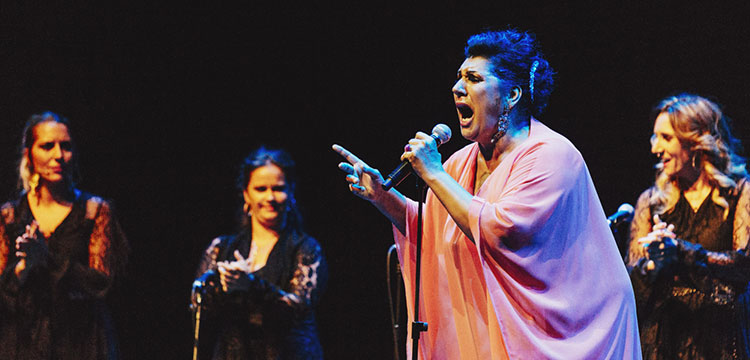“Gitanas”. Juana Amaya’s group. Dance: Juana Amaya and Nazaret Reyes. Guitar: Juan Campallo. Voice: Enrique ‘El Extremeño’, David Sánchez ‘El Galli’, Manuel Tañé y José Antonio Nuñez ‘El Pulga’. Percussion: Paco Vega. Tía Juana la del Pipa’s group. Voice: Tía Juana la del Pipa. Guitar: Raúl Moreno ‘El Perla’. Rhythm: Fabián Moreno ‘El del Pipa’, Tomás de los Reyes ‘El del Pipa’. Remedios Amaya’s group. Voice: Remedios Amaya. Guitar: Raúl Moreno ‘El Perla’. Rhythm and backup: Carmen Amaya, Samara Moreno, Rosario Villar and Ana Mari González. Percussian: Isidro Suárez. Teatro Maestranza. September 27th, 2016. Full house.
Sara Arguijo
The flamenco writer and journalist Paco Vargas said, in one of the heated debates these days on Facebook regarding the program of the Bienal, that “avant-garde is not an admirable quality unto itself”, and we couldn’t be more in agreement. Of course the concept extends equally to that which is orthodox, which is not any sort of guarantee of excellence. In the first place, because regardless of where the artist is performing, he or she must bring together basic talent and quality, and in the second place, because even given these circumstances, a show can still fall flat and of course be more or less satisfactory.
Which is why, if this review had been written beforehand, it would have emphasized the temperamental intuitive dancing of Juana Amaya, the earthy unshakeable singing of Tía Juana la del Pipa and the overwhelming personality of Remedios Amaya, without a doubt one of the best-loved singers of Seville the most anticipated in this Bienal, where people were extremely anxious to again enjoy this singer after a bout with cancer that had kept her away from the stage.
In other words, it would have been easy to resort to the lineage of their names, going over the background of each in the art of flamenco and praising their infinite virtues. The great extent to which these “Gitanas” powerfully leave their mark and the charisma they project from the moment they step on stage and direct themselves to an audience.
But, as we said, aside from their undeniable qualities, there are things that cannot be forgiven in a show, and more so in a theater such as the Maestranza (yet another temple of this city so given to crowning everything) where a mere 24 hours earlier we had attended a major work, El Salon de Baile, with exquisite technical and artistic work.
To put it differently, the complete lack of artistic direction, the terrible lighting, the continuous sound problems, the in and out of technicians during the performances, the more than ten minutes down time in the transitions (incomprehensible), and in general, the terrible staging shows a lack of respect for flamenco and the audience, although they applauded heartily and unconditionally, as you would expect.
Thus, what could have been a wonderful encounter of three of the biggest personalities in flamenco (they didn’t even come out to bow together) and been memorable, came off as an irregular uncontrolled show in which you had to continually bite your tongue and be content with the few sparks of glory from the women and guitarist El Perla who accompanied Tía Juana and Remedios Amaya extremely well, with depth and professionalism in the worst of circumstances.
A powerful Remedios Amaya was more imposing than the other two. After an ill-advised taranta, she shed the butterflies and let loose with tangos, a medley of all her most famous ones, from Turú Turai to the “barca”. Then, barefoot, and with her voice warmed-up, she let loose with her melodic canastero singing, like a queen of soul or a pop star, depending on the moment.
That’s the memory that sticks, but also the idea that not even purity and inspiration can shirk responsibility and artistic commitment.
